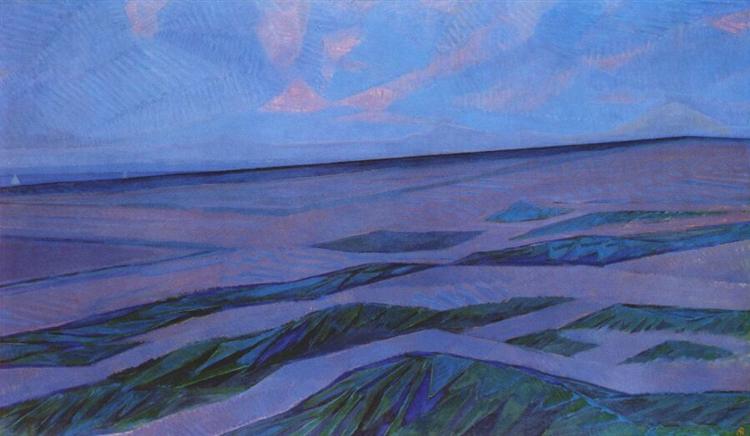Description
The work "Dunas landscape" of 1911, known in its original language as "Dune Landscape", is a fascinating example of Piet Mondrian's early approach to abstract art, before its total separation from figurative representations. In this painting, Mondrian portrays a coastal landscape that, through his characteristic style, shows the transition he was carrying out in his work, from a more traditional naturalism to a more abstract and geometric visual language that would reach its maximum expression in the later decades.
The composition of "Dunas landscape" presents a series of undulating hills that emerge from the background, representing the dunes in the context of a natural environment. This use of curved lines and organic forms contrasts with the geometric rigidity that would define its future work. The scheme of the work is a testimony of its representative base, where nature plays a primary role, but which already begins to deconstruct in favor of a more abstract expression.
In color terms, Mondrian uses a palette that is characterized by terrible and soft tones, predominantly the yellow, brown and green that evoke the serenity of the landscape. These shades, in turn, suggest a direct connection with the earth and the immediate environment of the artist, who at that time was deeply influenced by the light and the atmosphere of the landscapes that surrounded him. The way in which Mondrian uses color in this painting is essential to create a specific atmosphere that, although totally natural, begins to suggest the search for harmony and balance that would become central to his work.
It is important to note that, unlike many of his subsequent works, "Dunas landscape" does not present human figures as part of the visual narrative. The absence of characters allows the viewer to immerse itself in the tranquility of the landscape, offering a contemplation space that invites us to assess the relationship between man and nature. This approach reflects a connection philosophy that Mondrian would lead to his most abstract work, where the viewer becomes part of the aesthetic experience.
Despite being less recognized than his most iconic works such as "composition in red, yellow and blue", "Dunas landscape" is key to understanding the evolution of the artist. This painting It is a link in its development towards neoplasticism, a movement that it subsequently founded and that is characterized by the reduction to the essential through the use of straight lines and primary colors. In "Dunas landscape", the essence of his future work is already palpable; The search for order and balance that would eventually lead to the creation of a completely abstract visual grammar.
Through this work, Mondrian suggests his appreciation and respect for nature, and at the same time, his desire to explore the shape and color beyond literal representation. "Dunas landscape" is, therefore, a beautiful testimony of an artist in transition and a work that deserves to be contemplated with the same attention that would be granted to its most radical contributions to contemporary art. Ultimately, this painting is not only a landscape; It is a door towards the understanding of Mondrian's evolution towards his purest exploration of form and color, and a reminder of the power of art to capture the essence of human experience in its natural context.
KUADROS ©, a famous paint on your wall.
Hand-made oil painting reproductions, with the quality of professional artists and the distinctive seal of KUADROS ©.
Art reproduction service with satisfaction guarantee. If you are not completely satisfied with the replica of your painting, we refund your money 100%.

